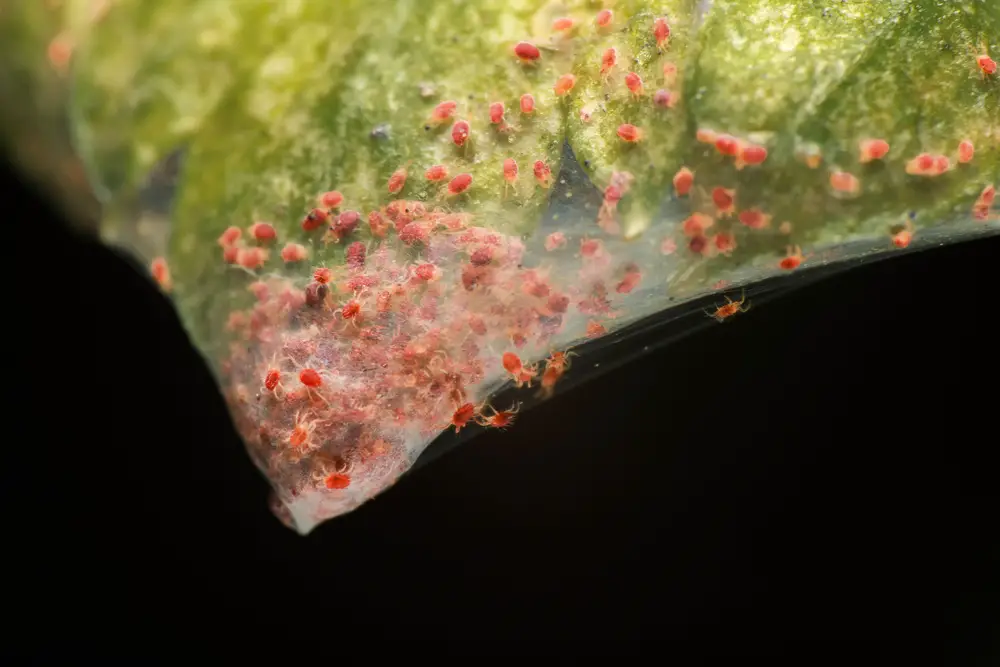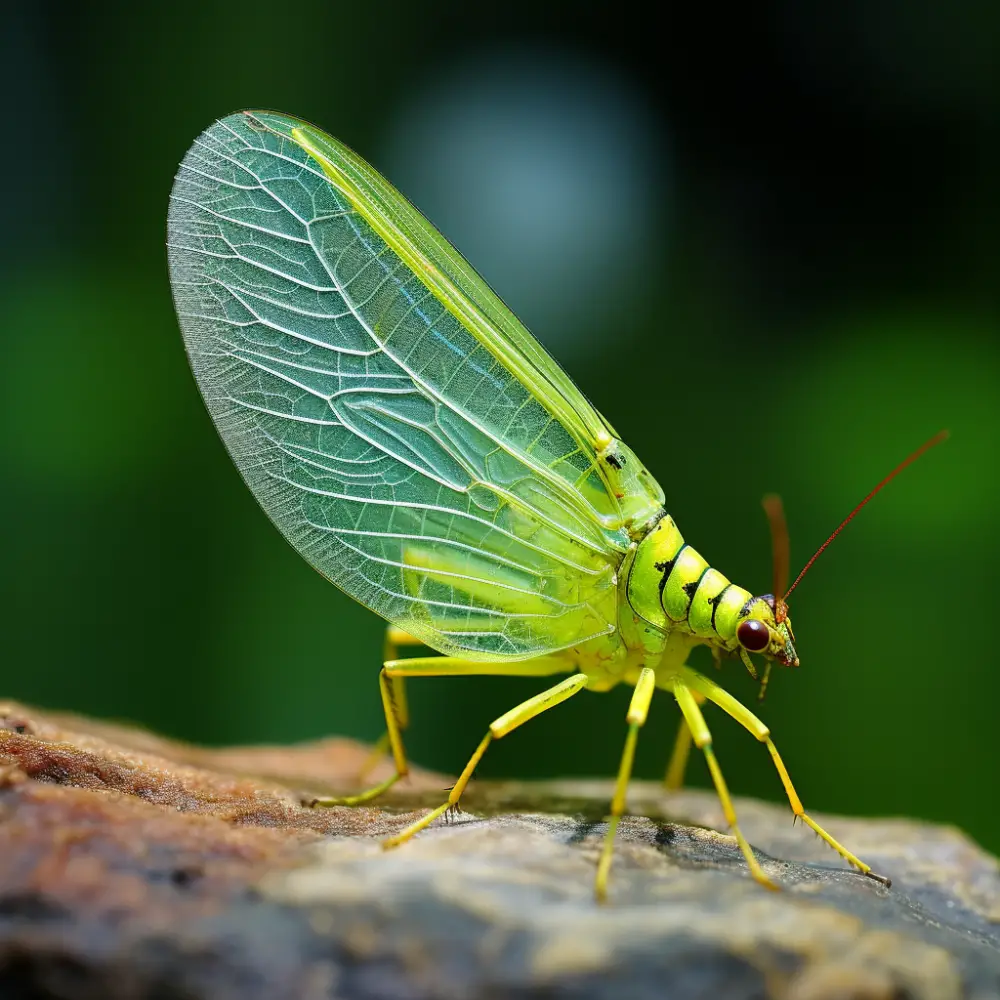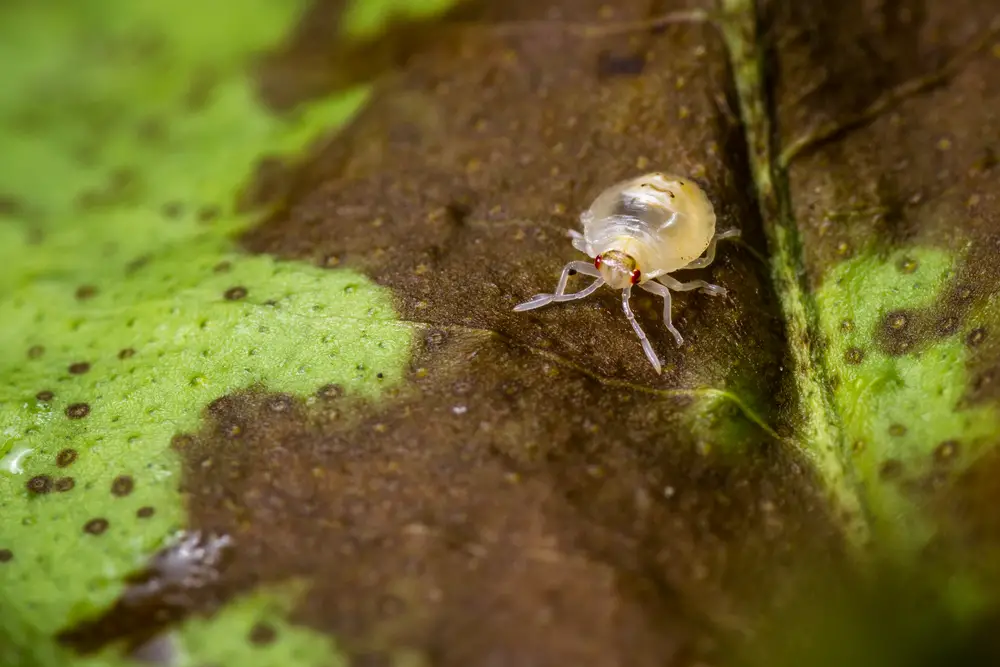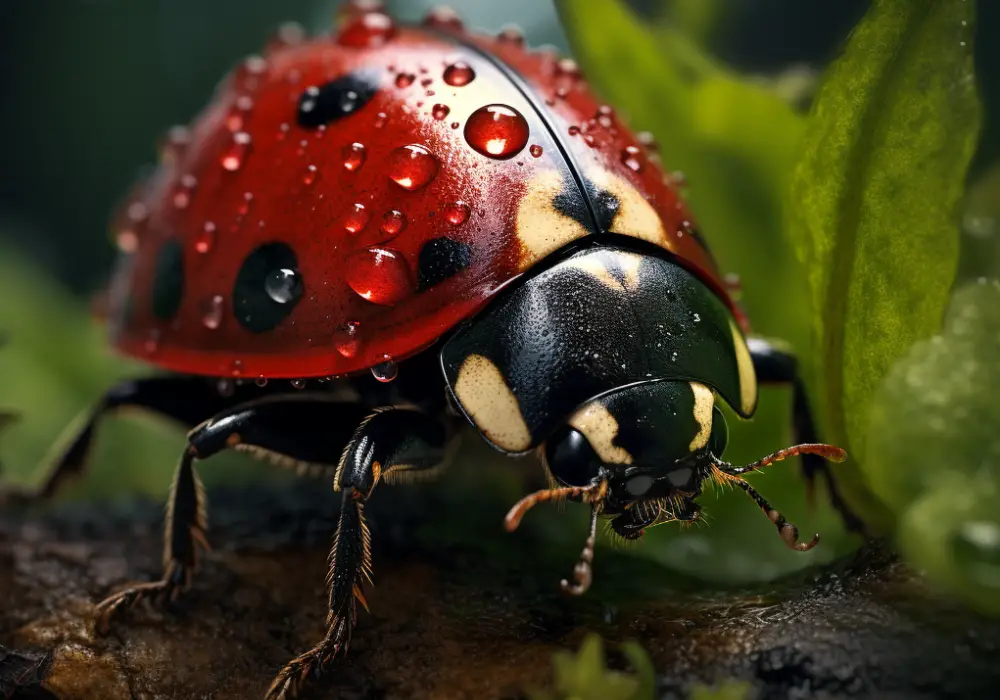Ladybugs are a common sight in gardens and are often seen as beneficial insects due to their ability to control pest populations.
Spider mites are tiny arachnids that feed on the sap of plants, causing leaves to yellow and wilt. They reproduce quickly and can quickly infest a garden if left unchecked.
Quick Answer:
Yes, ladybugs prey on spider mites. They are beneficial predators in gardens and greenhouses, helping manage mite populations. A single ladybug can consume numerous mites and their eggs each day, serving as a natural pest control solution.
Ladybugs, on the other hand, are known to be voracious predators of many garden pests, including aphids, mealybugs, and scale insects.
Understanding Ladybugs
Ladybugs, also known as ladybirds or lady beetles, are a type of beetle that belongs to the family Coccinellidae. These insects are known for their brightly colored, spotted appearance and are often considered a symbol of good luck.
Ladybugs are generally small in size, with most species measuring between 0.8 and 18 millimeters in length. They are found in a variety of habitats, including forests, fields, and gardens, and are known for their voracious appetite for aphids and other small insects.
The lifespan of a ladybug varies depending on the species and environmental conditions. Some species can live up to two years, while others only live for a few months.
The most common species of ladybug in North America is the Hippodamia convergens, which has a lifespan of about one year.
Ladybugs are beneficial insects that play an important role in natural pest control. They are particularly effective at controlling populations of aphids and spider mites, which are common garden pests. Ladybugs are also used as a natural alternative to chemical pesticides in organic farming.
Spider Mites and Their Impact
Spider mites are tiny arachnids that feed on plant sap, causing significant damage to crops and ornamental plants. Spider mite infestations are common in warm, dry environments, and they can quickly spread from plant to plant.
Spider mites cause damage to leaves by piercing the plant tissue and sucking out the sap. This results in small, white, or yellowish spots on the leaves, known as stippling. As the infestation progresses, the leaves may turn brown and fall off the plant. In severe cases, the plant may become stunted or die.

There are two common species of spider mites that affect plants: the two-spotted spider mite and the red spider mite. The two-spotted spider mite is more common and feeds on a wide range of plants, while the red spider mite prefers to feed on fruit trees and ornamental plants.
Spider mites are known for producing webs, which can cover leaves and stems. However, not all spider mites produce webs, and the presence of webs is not a reliable indicator of an infestation.
One of the most significant impacts of spider mites is the smell they produce. When spider mites feed on plants, they release volatile compounds that can give off a strong odor. This smell can be unpleasant and may attract other pests to the area.
In conclusion, spider mites can cause significant damage to plants, and their infestations should be treated promptly to prevent further damage.
Ladybugs as Predators
Ladybugs are known as generalist predators, meaning they eat a wide range of prey. They are voracious eaters and can consume up to 50-60 aphids per day. However, their appetite is not limited to just aphids. Ladybugs are also known to feed on other soft-bodied insects, such as whiteflies, mealybugs, and spider mites.
Spider mites are a common pest that can cause significant damage to plants. They are small and difficult to see with the naked eye, making them hard to control. However, ladybugs are effective at controlling spider mites.

They feed on both the eggs and the adult mites, which can significantly reduce their populations.
Ladybugs are not only effective at controlling spider mites, but they are also beneficial for the overall health of the ecosystem. They help to maintain a balance between predator and prey populations, which is essential for a healthy ecosystem.
Ladybugs are also a natural alternative to chemical pesticides, which can be harmful to the environment and non-target species.
Ladybugs and Spider Mites in Gardens
Ladybugs, also known as ladybirds, are a type of beneficial insect that can help control spider mite infestations in gardens. Spider mites are tiny pests that can cause significant damage to plants by sucking out their sap, leading to wilting and yellowing leaves.
Ladybugs are natural predators of spider mites and can be an effective long-term solution for controlling their population in gardens. They feed on spider mites as their primary food source and require a water source to survive.
To control spider mites using ladybugs, gardeners can release them into the affected area. Ladybugs can be purchased from garden centers or online.
It is important to release them at the right time, when spider mites are present, and to provide them with a food source and water source.
Patience is key when using ladybugs for pest control. It can take some time for them to establish a population and start controlling spider mites effectively. However, they can be a sustainable and environmentally friendly solution for managing spider mites in gardens.
Attracting Ladybugs to Your Garden
Ladybugs are natural predators of spider mites and can help control their population in your garden. To attract ladybugs to your garden, there are a few things you can do.
Provide Flower Nectar
Ladybugs feed on flower nectar as well as insects, so planting flowers that produce nectar can help attract them to your garden. Some good options include:
- Dill
- Cilantro
- Tansy
- Cosmos
- Dandelion
- Clover
- Yarrow
Create a Ladybug Habitat
Ladybugs need a place to live and lay their eggs, so creating a habitat for them can help attract them to your garden. You can do this by:
- Providing shelter: Ladybugs like to hide in tall grass, under leaves, and in other sheltered areas. Leave some areas of your garden untrimmed to provide shelter for them.
- Providing water: Ladybugs need water to survive. Place a shallow dish of water in your garden to provide them with a source of hydration.
Lure Ladybugs to Your Garden
If you want to attract ladybugs to your garden quickly, you can purchase them online or at a garden center and release them in your garden.
However, it’s important to note that releasing ladybugs may not be effective if your garden doesn’t provide a suitable habitat for them.
Other Predators of Spider Mites

Apart from ladybugs, there are several other predators that can help control spider mite populations.
These predators can be categorized into insects and arachnids.
Insects
Lacewings
Lacewings are known to feed on spider mites, among other pests. They are attracted to gardens and can be attracted by planting flowers that they like. Lacewing larvae are voracious predators and can eat up to 200 spider mites in a week.
Green Lacewing
Green lacewings are another type of lacewing that can help control spider mites. The larvae of green lacewings are known to be effective predators of spider mites. They can consume up to 20 spider mites a day.
Tiny Caterpillars
Some tiny caterpillars, such as those of the predatory thrips, can also feed on spider mites. These caterpillars are small and can be difficult to spot, but they can be effective in controlling spider mite populations.
Arachnids
Spiders
Some species of spiders are known to feed on spider mites. These spiders include the jumping spider, the crab spider, and the orb weaver spider. While spiders can be effective in controlling spider mites, they can also be harmful to other beneficial insects in the garden.
Predatory Mites
Predatory mites are another type of arachnid that can help control spider mites. These mites are tiny and can be difficult to see with the naked eye. Some common species of predatory mites include Phytoseiulus persimilis and Amblyseius andersoni.
Stethorus
Stethorus punctum is a small beetle that feeds on spider mites. These beetles are effective predators and can consume up to 75 spider mites a day. They are also known to feed on other pests, such as aphids and whiteflies.
Spined Soldier Bugs
Spined soldier bugs are another type of predator that can help control spider mites. These bugs are known to feed on a variety of pests, including spider mites. They are also known to feed on nectar and can be beneficial to pollinators in the garden.
Spider Mites and Indoor Plants

Spider mites are a common pest that can infest indoor plants, including those grown in greenhouses and homes. These tiny arachnids are difficult to spot with the naked eye, but their damage can be seen as yellowing leaves and webbing on the plant.
Spider mites feed on the sap of the plant, which can weaken it and make it more susceptible to disease. They reproduce quickly, so it’s important to catch an infestation early and take action.
There are several ways to control spider mites on indoor plants, including:
- Spraying the plant with water to knock off the mites
- Using insecticidal soap or neem oil
- Introducing natural predators, such as ladybugs or predatory mites
It’s important to note that not all pesticides are effective against spider mites, and some can even make the problem worse by killing off beneficial insects.
Spider mites can be especially problematic for cannabis plants, as they can affect the potency and flavor of the buds. It’s important to monitor plants closely and take action at the first sign of an infestation.
For vegetables grown indoors, it’s important to maintain a clean and healthy environment to prevent spider mites from taking hold. Regularly inspecting plants for signs of infestation and taking quick action can help keep them at bay.
Alternative Methods for Spider Mite Control
While ladybugs are a popular natural predator for spider mites, there are other alternative methods for controlling these pests. Here are some options to consider:
- Pesticides: Chemical pesticides can be effective in controlling spider mites, but they may also harm beneficial insects and other wildlife. It’s important to carefully read and follow the instructions on the label, and to use pesticides sparingly and only when necessary.
- Insecticides: Insecticides can also be effective against spider mites, but like pesticides, they can harm beneficial insects. It’s important to choose an insecticide that is specifically labeled for spider mites, and to use it according to the instructions on the label.
- Neem Oil: Neem oil is a natural insecticide that can be effective against spider mites. It works by disrupting the mites’ hormonal balance, preventing them from reproducing. Neem oil can be applied directly to plants, but it may also harm beneficial insects.
- Insecticidal Soaps: Insecticidal soaps are another natural option for controlling spider mites. They work by suffocating the mites and disrupting their cell membranes. Insecticidal soaps can be applied directly to plants, but they may also harm beneficial insects.
- Diatomaceous Earth: Diatomaceous earth is a natural substance made from the fossilized remains of diatoms. It works by dehydrating spider mites and other insects, causing them to die. Diatomaceous earth can be applied directly to plants, but it may also harm beneficial insects.
- Garlic: Garlic has natural insecticidal properties and can be effective against spider mites. To use garlic as a natural pesticide, crush several cloves of garlic and mix them with water. Strain the mixture and spray it directly onto plants.
- Buying Ladybugs: Ladybugs can be purchased from online retailers and other sources. However, it’s important to note that not all ladybugs are effective against spider mites. It’s also important to release ladybugs at the right time and in the right location, and to provide them with a suitable habitat.
Understanding Spider Mite Life Cycle
Spider mites are tiny arachnids that feed on plant sap and can cause significant damage to crops and gardens. Understanding their life cycle is crucial in controlling their population.
Spider mites have a short life cycle, and their development from egg to adult takes around 1-3 weeks, depending on the temperature and humidity. The life cycle of spider mites consists of four stages: egg, larva, nymph, and adult.
Eggs
Spider mites lay their eggs on the leaves of plants, and the eggs are usually spherical and transparent. The eggs hatch in 2-5 days, depending on the temperature and humidity.
Larvae
When the eggs hatch, they release six-legged larvae that are pale yellow or green. The larvae feed on the plant sap and molt twice before becoming nymphs.
Nymphs
The nymphs are eight-legged and resemble the adults. They also feed on the plant sap and molt twice before becoming adults.
Adult Mites
The adult spider mites are oval-shaped and have two red or green spots on their backs. They can be either male or female, and their lifespan is around 2-4 weeks. During this time, they can produce hundreds of eggs, leading to a rapid increase in population.
Spider mites can also lay their eggs on insect eggs or pupae, which can serve as a food source for the larvae.
Other Pests That Ladybugs Eat
Ladybugs are known to be voracious predators of many types of pests, making them a popular choice for natural pest control. In addition to spider mites, ladybugs also feed on a variety of other pests.
One common pest that ladybugs eat is aphids. These small, soft-bodied insects are a common problem in gardens and can cause damage to plants by sucking out their sap. Ladybugs are particularly effective at controlling aphids, as they can consume large numbers of them in a short period of time.
Ladybugs also prey on whiteflies, which are small, winged insects that feed on the undersides of leaves. Like aphids, whiteflies can cause damage to plants by sucking out their sap.
Ladybugs are effective at controlling whiteflies, as they can consume both the adults and the larvae.
Another pest that ladybugs eat is scale. Scale insects are small, immobile pests that attach themselves to plant stems and leaves. They can cause damage to plants by sucking out their sap. Ladybugs are effective at controlling scale, as they can consume both the adults and the larvae.
Mealybugs are another common pest that ladybugs eat. These small, soft-bodied insects are covered in a white, waxy substance and can cause damage to plants by sucking out their sap.
Ladybugs are effective at controlling mealybugs, as they can consume both the adults and the larvae.







